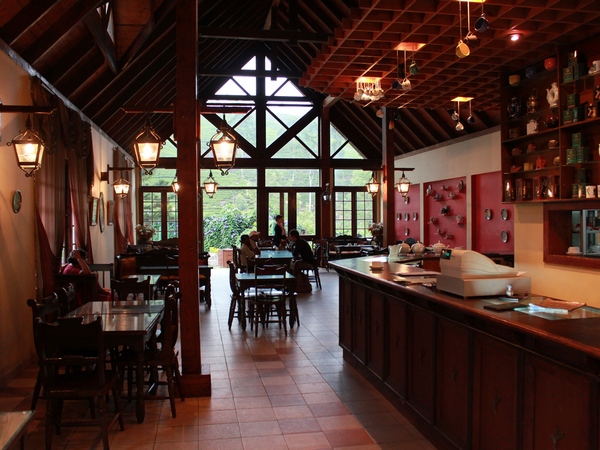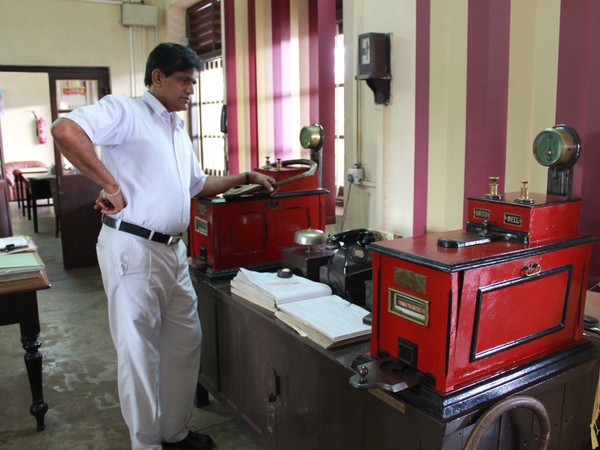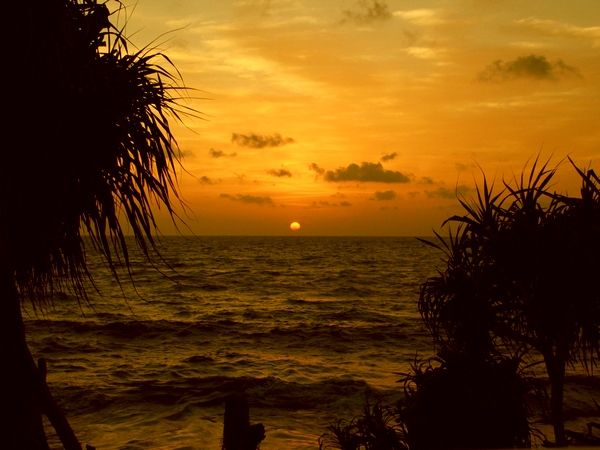 | « Back to article | Print this article |
PHOTOS: The quiet dignity of Sri Lanka
There is more in common between Sri Lanka and India than we can imagine. Part three of a travelogue.
Read part one here and part two here.
Subhash pulls over his tuk-tuk as we're taking a walk along the lake and makes his offer -- LKR 2500 for a trip to a tea factory, a spice garden, a viewing of the Bible Rock and the Millennium Elephant Foundation.
We tell him we'd rather go to Pinnawala Elephant Orphanage about 5km further down from the Millennium Foundation. Much bargaining ensues and after about 15 minutes, we settle for LKR 1300 to Pinnawala and back.
All the way he insists on telling us what a terrible decision we'd be making because "at Millennium you get to play with the elephants, feed them and even sit on them... all in one ticket".
"But in Pinnawala, you only get to see them bathing," he tells us.
Having read that most elephants at Millennium were quite old, we had no intentions of sitting on them, least of all play with them. We told him, if at all we'd feel terribly sorry about the whole thing and assured him that we didn't want to do any of it. Nevertheless there was no convincing him otherwise.
After much debate we finally did watch the famed elephants of Pinnawala frolicking in the river nearby.
It is quite a sight, admittedly -- the tourists as much the elephants -- watching in sheer awe the beasts are taken out of the orphanage in a single file to the river and back. The traffic on the road is brought to a halt even as the owners of the shop alongside the lake stop to see.
Subhash did take us to see the spice gardens and a tea factory, neither of which were half as exciting as he seemed to promise. But a detour to a mask factory proved to be a great photo opportunity. (Pictures here)
A view of the Bible rock along the way was quite a sight though and the lush green forests below being the only reminder of Utuwankande Sura Saradiel, Sri Lanka's very own Robin Hood, whose stronghold it used to be.
PHOTOS: The quiet dignity of Sri Lanka
By now, I was quite sure we could go all the way to Jaffna (which I'd been dying to visit) but a silly error of judgement led us to book a hotel online in Nuwara Eliya, a hill station south of Kandy. Being unable to cancel the booking now, we decided to head there anyway, a decision we didn't regret once we got there.
So far we'd been relying on the train and we did the same for this leg of our journey too. Only this time the train was crowded and the journey never seemed to end. We managed to get seats but only half way there and it was afternoon by the time we reached the place.
Nuwara Eliya itself does not have a railway station -- the closest rail head is Nanu Oya about 5km away from where you must take a bus.
As everywhere else, much of the activity in Nuwara Eliya is centred around the bus station. Even though we couldn't find a cheap hotel online (we spent close to LKR 3500 for a night) we discovered there were plenty of options once we got there.
Khasun Rattnayake and Shiromi Nanayakkara are a couple that run Mount View Cottage about 4km to the north of the bus station. Though slightly expensive for our budget, it was a charming place with fantastic views of the valley that surrounded it.
Much like India's Mussoorie or Darjeeling, Nuwara Eliya continues to be a small town retaining a distinct colonial flavour and ends before it begins. Yet it houses at least two swanky departmental stores -- Cargills and Keels Super -- and a bunch of mid-level eateries that are so often lacking in Sri Lanka. The one we visited and recommend strongly is De Silva Food Centre along the Bazaar Street -- it is clean and affordable. There also are a bunch of roadside stalls selling hot, crunchy, dripping-in-oil but tempting snacks for as little as LKR 5-10 that are well worth a try.
Having arrived in Eliya in the afternoon, we'd spent most of the day travelling (and about an hour eating). We were certain we wanted to head to the ancient city of Anuradhapura the day after so it left us with less than a few hours to explore the places around Eliya.
It all boiled down to one of the two places since they were about 20 km in two different directions: the Sita Amman Temple -- the only one dedicated to Sita and said to be the exact spot where she was held captive -- or the Mackwoods Labookellie Tea Estate.
Having read most of the guidebook, the girlfriend decided the Tea Estate was a good bet. Needless to say there was no debate on the matter and it did turn out to be a damn good decision.
With tea plantations on both sides and breathtaking views at every turn, the 20km ride downhill is a dream. The estate is one of the largest in Sri Lanka and a popular tourist attraction. The staff, warm and helpful, offer free (and informative) tours of the factory and are happy to play host in the charming cafe pictured above.
Spend some time here, if only to watch the clouds descend upon the sprawling estate or for cup of tea (on the house) and brownies (LKR 60).
PHOTOS: The quiet dignity of Sri Lanka
In spite of its size, travelling seems to be one of the greatest challenges in Sri Lanka to this day.
Many of the smaller towns seem to lack convenient direct connections, which means sometimes you have no option but to take a detour to a larger city and change transport.
Our next stop was Anuradhapura, the ancient city and the country's former capital. And for the first time in our journey we decided to take the road (via Kandy), which as it turned out is a much faster way to travel than the trains.
The journey back to Kandy took us full two hours less than we'd spent in the train. The journey to Anuradhapura from there on was just as fast if not faster since we were travelling along the plains.
Another pleasant discovery was the existence of air-conditioned mini buses (which we'd scorned en route to Kandy because it cost twice as much as the regular ones). We were to learn that these buses were not just faster but also take lesser stops and do not permit standees.
Usually these buses leave 10-15 minutes before the regular non-AC ones plying on the same route and are almost always parked next to them. A caveat though: None of the buses are equipped to carry large luggage which must be carried either on your lap in between seats.
We arrived in Anuradhapura close to 2pm a little tired our bones rattling part because a good part of the road beyond Dambulla is under repairs, but merciful that we'd taken an AC bus because the temperatures along the plains are considerably high and the land arid.
A courteous lawyer travelling to Anuradhapura pointed us to a sprawling Sri Lankan government rest house along Jayanthi Mawatha that few people (including authors of our guide book) seemed to be unaware of.
Though not the most comfortable, the resort is the only other accommodation besides Ceybank's Rest House close to the ancient city. The rest are to the east of the railway line in the New Town which is also where most of the convenience stores, restaurants and banks are located.
The government rest house was a good enough place, though somewhat spooky since we seemed to be the only other guests besides a local Sri Lankan fellow who walked up to us quite calmly and told us he was here to pray for the world, 'you know, since it will all come to an end this year'.
About the same time, we decided we'd had enough of Anuradhapura and that we'd head back to Colombo the next afternoon soon after our trip to the ancient city.
Most sites in the ancient city of Anuradhapura are accessible to foreign tourists for a fee. Yet again our Indian passports got us a 50 per cent discount and along with a tuk-tuk driver we'd hired for the trip, we drove around the ruins of what must've been one mighty city by any standards.
PHOTOS: The quiet dignity of Sri Lanka
Anuradhapura isn't a city you can traverse on foot. A bicycle (LKR 550 per day) or a tuk-tuk (LKR 1500 for a four-hour trip of the eight most popular spots in the city and LKR 100 per extra hour) is the most preferred mode of transport. For some reason even though motorbikes are the most practical way to travel around the ruins, rentals are unheard of.
When we visited it, the ancient city was deserted though our guidebook assured us that it got pretty crowded over the weekends and on auspicious days.
Situated in the heart of the country, the history of Anuradhapura, (and effectively the rest of the country) has been turbulent. At the peak of its glory Anuradhapura was inarguably one of the greatest cities in the world. The city was a cultural capital that boasted of monasteries housing over 10,000 monks at a time and dagobas second in scale only to the Pyramids of Giza. It was also the centre of Sri Lanka's hydraulic feats with huge reservoirs designed to store and supply water to the dry arid lands that surrounded the city and enjoyed a reputation in and did fair amount of trade with countries as far as Greece and Rome.
Anuradhapura saw innumerable highs and as many lows. Having risen to dizzying heights around c300-260BC under Devanampiya's rule and later again during the reign of Dutugemuni (161-137 BC), Anuradhapura never recovered its former glory and suffered at the hands South Indian rulers who attacked it from time to time. Finally, in 993 AD the Cholas from Tamil Nadu destroyed Anuradhapura completely and set up their capital further south at Polonnaruwa.
While a few half-hearted efforts were made to restore it, the city was largely consumed by the forest, leaving just a few communities of monks who guarded the holy Bodhi tree that grew from the branch of the same tree under which Buddha is said to have gained enlightenment.
It was left to the British to rediscover this city and make Anuradhapura a provincial capital in 1833. Today, the tree stands in its full glory at Sri Maha Bodhi and is surrounded by a temple (and a strong presence of the Sri Lankan Army).
How long you take to explore Anuradhapura depends entirely on how interested you were in the pictures of Mohenjo-Daro in your school text book. Nonetheless just walking around the ruins can be overwhelming, to know that you stand at the very spot where once a country was born and a culture flourished.
PHOTOS: The quiet dignity of Sri Lanka
The last leg of our journey -- from Anuradhapura to Colombo -- was perhaps the most comfortable. Travelling on a reserved seat for the first time in an almost empty compartment and bags tucked away safely we stretched out our legs for probably the first time during an inter-city travel.
Then it happened -- a fire along the railway line delayed by train by about two hours. We landed in Colombo close to 10pm and no hotel room booked in our name. After almost two anxious hours, we finally checked into a somewhat seedy hotel and checked out the first thing next morning to find another one.
While in Colombo expect the room rates to be slightly higher than in the rest of the country. We spent LKR 2,000 per night in Colombo as against LKR 1500 in most other places. We discovered a clutch of very decent places offering a budget accommodation in Mt Lavinia a distant suburb of Colombo along Galle Road. We stayed at a hotel close to Mt Lavinia railway station which translated into a 20-minute train ride to the city centre of Colombo (alternatively you take a bus that travels along Galle Road and takes about 45-50 minutes).
As it happened, in the two days that we stayed there, we saw very little of Colombo's tourist spots. Instead we did what most tourists do -- shopped!
A quick word about shopping in Colombo -- the government-run Laksala is not necessarily the best or the cheapest place to buy knickknacks for people back home. Instead try Odel, a Sri Lankan departmental store with branches in Colombo and Kandy as well as inside the duty free area of the Bandaranaike International Airport, which itself is a goldmine for shoppers with branded goods being available for considerably throwaway prices.
Cricket isn't the only thing that's common to Colombo and Mumbai. Both the cities have natural harbours and have been their respective countries' commercial capitals. Much like Mumbai, Colombo has a fair bit of colonial history and a cosmopolitan air that few places in Sri Lanka can boast of.
With a robust bus transport system and fairly decent railway system, Colombo is pretty much the only city in Sri Lanka that offers a wide variety of career options. It isn't unusual for young people to be renting up apartments in the city and travelling back to their hometowns/villages over the weekends.
There is a fair bit to see in Colombo including the National Museum that contains regalia of the 17th century Kandyan Kings, the Natural History Museum and the Dutch Period Museum. There is also the Galle Face Road a 13km long promenade that attracts visitors young and old.
In many ways though, the real Colombo is in its streets. Giving sightseeing a pass, we spent most of our times walking around the city, taking in the sights and scenes.
However one of the best experiences in Sri Lanka is the local train. Make sure you keep a few hours for it and take one all the way to Mount Lavinia (or even beyond) and back. For a good part, the line runs quite literally ALONG the sea. Even for people like us who've been raised in a city by the sea, this was one of our most exhilarating experiences.
Mount Lavinia too is a fantastic place to be. The beach is great, people friendly and has a good deal of nightlife. Also along the beach are a fair bit of restaurants that cater food to suit every budget.
We were to learn later that it also serves as the gay district of Colombo. Not that there are any gay bars that we knew of but it is fairly gay friendly and hosts Colombo's Gay Pride week in June.
Our journey was almost drawing to a close now and Colombo was making us more homesick than ever. We really missed Mumbai.
So that's where we headed -- on to a train, back on a plane, into a cab and six stories up. And just like that... with a turn of the key and a click of the latch, our journey ended just as we began; and not unlike Dorothy of Wizard of Oz, we were finally home.




